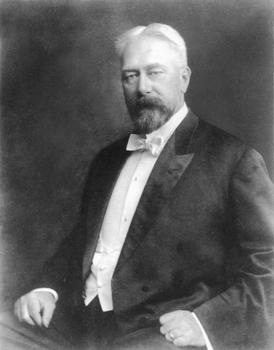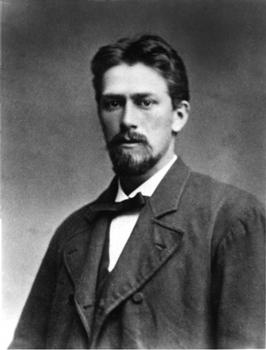German-American engineer.
Biographical Information
| Name: | Gustav Lindenthal |
|---|---|
| Born on | 21 May 1850 in Brno, South Moravian Region, Czechia, Europe |
| Deceased on | 31 July 1935 in Metuchen, Middlesex County, New Jersey, USA, North America |
| Education: | Apprenticeship as macon, then studies at the Polytechnicum in Dresden |
| 1870 - 1874 | Bridges in Austria and Switzerland |
| 1874 | Immigrates to the United States |
| 1874 - 1877 | Engineer for the Centennial Exposition in Philadelphia |
| 1877 - 1890 | Engineering office in Pittsburgh |
| 1890 | Moves to New York |
| 1902 - 1903 | Commissioner of New York bridges |
| 1909 | Manhattan Bridge |
| 1931 | Bayonne Bridge over the Kill van Kull with Othmar Ammann |
| 1933 | (1934?) Honorary Doctoral Degrees from the German Technical School in Brünn (Brno) and Technical School in Dresden |
Structures and Projects
Participation in the following structures & large-scale projects:
Biography from Wikipedia
Gustav Lindenthal (May 21, 1850 – July 31, 1935) was a civil engineer who designed the Hell Gate Bridge in New York City, among other bridges.:283 Lindenthal's work was greatly affected by his pursuit for perfection and his love of art. His structures not only serve the purpose they were designed for, but are aesthetically pleasing to the public eye. Having received little formal education and no degree in civil engineering, Lindenthal based his work on his prior experience and techniques used by other engineers of the time.
Early life
Lindenthal was born in Brünn, Austrian Empire, now Brno, Czech Republic in 1850. Lindenthal began to receive practical training in 1866 when he was employed as a mason and carpenter. At the age of 18, Lindenthal left his family to set out to make a life of his own in Vienna, Austria.
Career
When he arrived in Vienna he became an assistant in the engineering department for the Empress Elisabeth Railway of Austria. Two years later he joined the Union Construction Company, where he gained experience in building incline planes and railroads. Then a year later he decided to join the Swiss National Railroad, where he was hired on as a division engineer in charge of location and construction. While living in Vienna, he attended some public engineering lectures at a local university. However, he never did actually attend the university or receive a degree. Lindenthal in fact taught himself mathematics, engineering theory, metallurgy, hydraulics, estimating, management, and everything else that a successful bridge engineer needed to know. Nevertheless, the lack of his formal education hindered him from further advancement in Europe, so he decided to emigrate to the United States in 1874.
When he first arrived in the United States he was employed as a journeyman stonemason for the memorial granite building of the Centennial International Exhibition in Philadelphia (Janberg 2006). After completion of this project, Lindenthal worked for the Keystone Bridge Company of Pittsburgh, Pennsylvania, on numerous projects over a three-year period. While working for this company, he gained valuable experience which propelled him to the status of bridge engineer. He worked for the Atlantic and Great Western Railroad during 1879 to 1881.
In 1881, Lindenthal established his own consulting business and built four bridges in the Pittsburgh area: 30th Street Bridge (Herrs Island); Smithfield Street Bridge (over the Monongahela River; 1883), Youghiogheny River Bridge at McKeesport (1883); and the Seventh Street Bridge (Allegheny River; 1884).:129 In 1884, he founded the North River Bridge Company in New York, with the intent of building a massive bridge over the Hudson River for the Pennsylvania Railroad (PRR).:20 Although the PRR ultimately decided to build tunnels under the river rather than a bridge, the two companies continued their relationship. The PRR hired Lindenthal in 1904 to work on the New York Connecting Railroad and lead the Hell Gate Bridge project. The completed bridge was dedicated by Lindenthal and the PRR on March 9, 1917.:297
The City of New York appointed Lindenthal Commissioner of Bridges in 1902. He worked on several East River bridge projects and directed the Queensboro Bridge project, which was completed in 1909.
The North River Bridge Company developed another proposal for a large Hudson River suspension bridge in 1920. This design would have been built at 57th Street in Manhattan, to carry both roadway and railroads, but neither the city nor the railroads were supportive. (Lindenthal's colleague Othmar Ammann developed a scaled-down bridge proposal several years later, which became the George Washington Bridge, completed in 1931.) Lindenthal worked on several other bridge projects around the country in the 1920s. Perhaps his most famous and lasting achievement outside of New York is the massive Sciotoville Bridge across the Ohio River, completed about the same time as the Hell Gate Bridge.
At the age of eighty-five, Lindenthal succumbed to a long illness and died shortly after, at his home in Metuchen, New Jersey. Up until that point, he remained active as president and chief engineer of the North River Bridge Company.
Standard engineering practices
Lindenthal had a difference in opinion with one of the standard engineering practices of the day. Trains were very popular during this time and made up a majority of large bridge building that took place. Trains being as heavy as they were made engineers greatly overcompensate and build bridges that were oversized, bulky, and expensive. Lindenthal pointed out that bridges did not have to support the full load of a train. The train moves across the bridge and displaces its load evenly. This was not how the bridges were tested to see if a design worked though. The train's dead weight was simply added to the bridge, and if it did not hold, it was said to be structurally unstable. Lindenthal's idea of not having to carry the full load allowed bridge designers to create bridges that were still stable, but at the same time much lighter and cheaper.
Structural accomplishments
Gustav Lindenthal made bridges that reached new heights for his time. At the time of Hell Gate's completion, the bridge stood as the longest and heaviest steel bridge in the world. Gustav Lindenthal also expanded the idea of "double decker" lanes on his bridges. The Queensboro Bridge is one of the bridges Lindenthal designed that displays the double decker idea.
Construction techniques
During the time Lindenthal practiced engineering, the railroad industry was expanding and replacing many wooden-truss bridges with stronger ones capable of handling the heavier locomotive loads. In order to accommodate these heavier trains, different construction materials were being utilized. The materials being considered by engineers like Lindenthal were reinforced concrete, cable, and steel. Steel and reinforced concrete were two main materials used in the truss bridges Gustav Lindenthal designed. The use of reinforced concrete was a relative new idea in bridge construction, with its first use in 1889.
The design of the Hell Gate Bridge required a different approach to bridge construction. Nearly all major members of Hell Gate are composed of smaller trusses. The erection of the Hell Gate was carried through without the assistance of any falsework, or work that was not part of the actual bridge. This was accomplished by building the two halves of the arch simultaneously from each tower. The steel work was supported with the use of cables during construction to carry the load of the arches until they finally met at the center of the span.
In another instance, a bridge needed to be constructed over the Monongahela River, after the ferry, which was used for many years beforehand, became outdated. The first bridge, designed by John Roebling, continuously swayed and deflected, as well as being "shaky and loose." Lindenthal was then given an opportunity to design a replacement, the Smithfield Street Bridge in Pittsburgh. This bridge, completed in 1883 using the structural form of a lenticular truss, could withstand higher stresses, as well as using resources that made it more economical (Approximately $23,000 was saved simply by using these materials). "Lindenthal's use of steel instead of iron wherever possible was based upon economy as much as anything."
Gustav Lindenthal Medal
The International Bridge Conference is the site of the annual presentation of the Gustav Lindenthal Medal. Winners have included the Millau Viaduct, the Deh Cho Bridge and the Juscelino Kubitschek Bridge.
Text imported from Wikipedia article "Gustav Lindenthal" and modified on July 22, 2019 according to the CC-BY-SA 4.0 International license.
Bibliography
- (1883): Rebuilding of the Monongahela Bridge, at Pittsburgh, Pa.. In: Transactions of the American Society of Civil Engineers, v. 12 ( 1883), pp. 353-385.
- (1885): Discussions on the Report of the Committee on the Preservation of Timber; and Committee on the Preservation of Forests. At the Annual Conventionof the society, June 24th, 1885. In: Transactions of the American Society of Civil Engineers, v. 14, n. 1 ( 1885), pp. 372-398.
- (1899): Electricity Versus Steam For Branch Railroad Lines. In: Transactions of the American Society of Civil Engineers, v. 42, n. 2 (December 1899), pp. 375-484.
- (1905): A Rational Form of Stiffened Suspension Bridge. In: Transactions of the American Society of Civil Engineers, v. 55, n. 2 (December 1905), pp. 1-15.
- (1922): The Continuous Truss Bridge Over the Ohio River at Sciotoville, Ohio, of the Chesapeake and Ohio Northern Railway. In: Transactions of the American Society of Civil Engineers, v. 85, n. 1 ( 1922), pp. 910-953.
Relevant Websites
Relevant Publications
- (1994): Der Bauingenieur. Geschichte eines Berufes. Verlag für Bauwesen, Berlin (Germany), pp. 223.
- (1995): Engineers of Dreams. Great Bridge Builders and The Spanning of America. Vintage Books, New York (USA), pp. 122-216.
- : La torre y el puente. El nuevo arte de la ingeniería estructural. CINTER, Madrid (Spain), ISBN 978-84-939305-4-7, pp. 300.
- (1983): The Tower and the Bridge. The New Art of Structural Engineering. Princeton University Press, Princeton (USA), pp. 122-5.
- (2013): Der Turm und die Brücke. Die neue Kunst des Ingenieurbaus. Wilhelm Ernst & Sohn Verlag für Architektur und technische Wissenschaften, Berlin (Germany), ISBN 978-3-433-03077-6.
- About this
data sheet - Person-ID
1000044 - Published on:
05/01/1999 - Last updated on:
22/07/2014






